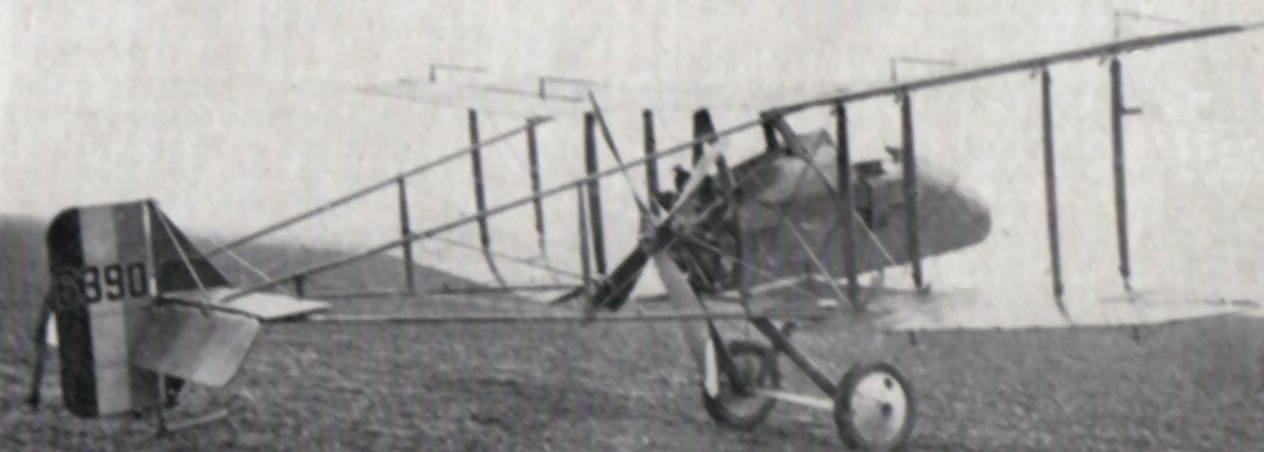- Royal Aircraft Factory F.E.8
Infobox Aircraft
name = F.E.8
type = Pusherbiplane fighter
manufacturer =Royal Aircraft Factory , Darracq Motors, Vickers
caption = Darracq-built F.E.8
designer = J. Kenworthy
first flight = September 1915
introduced =2 August 1916
retired =
status =
primary user =Royal Flying Corps
more users =
produced =
number built = 295
unit cost =
variants with their own articles = The Royal Aircraft Factory F.E.8 was a British single-seat fighter of the First World War designed at the Royal Aircraft Factory.Design and development
Like the D.H.2, the F.E.8 was designed as a pusher in order to provide a forward firing machine gun mount at a time when no synchronization gear was available to arm a tractor aircraft in the same way. Although a clean and well designed little aeroplane, for a pusher – it could not escape the drag penalty imposed by its tail structure and was no match for the Halberstadt and Albatros fighters of late 1916.
The nacelle was, most unusually for the time, an all-metal structure – being framed in steel tube and covered with
duralumin . The prototypes were initially each fitted with a large pointed propeller spinner, while the Lewis gun was fitted on a movable mount within the nose of the nacelle. For production machines the spinner was omitted, and the gun was mounted directly in front of the pilot, in the manner of the D.H.2.The new fighter was not a great improvement on the D.H.2 – although a little faster it did not handle quite so well. It was nonetheless ordered into production from Darracq motors and Vickers. Neither manufacturer delivered their F.E.8s particularly quickly, so that it ended up reaching the front in numbers six months later than the D.H.2.
Operational history
Two F.E.8s were issued to No. 29 Squadron RFC, a D.H.2 unit, in June 1916, but it was not until August that No. 40 Squadron became fully operational on the type. The only other unit to fly the type, No. 41 Squadron, arrived in France in October.
After a fairly good start, the F.E.8 units quickly ran into problems with the new German fighters. On the 9th of March 1917 nine F.E.8 of No. 40 Squadron had a dogfight with five
Albatros D.III s ofJagdstaffel 11 , led byManfred von Richthofen himself. Four F.E.8s were shot down, four others badly damaged, and the survivor caught fire when landing. After this disaster No. 40 Squadron was re-equipped with Nieuports and No. 41 restricted toground attack duties. No. 41 actually kept their pushers until July 1917 – becoming the last pusher fighter squadron in France. Two F.E.8s were sent to Home Defence units in 1917, but the type was not adopted as a home defence fighter.Reproductions
Old Rhinebeck Aerodrome's founder, Cole Palen, built the first flyable reproduction of an F.E.8, which is believed to have first flown in 1970 at Old Rhinebeck with a Le Rhône 80 hp rotary engine. It flew in the weekend air shows at Old Rhinebeck for a number of years, before being retired. It is currently in the collection of the
National Air and Space Museum .The Owl's Head Transportation Museum in Maine has another F.E.8 reproduction in its collection, powered by a modern air-cooled, horizontally opposed engine.
Operators
;UK
*Royal Flying Corps
**No. 5 Squadron RFC
**No. 29 Squadron RFC
**No. 40 Squadron RFC
**No. 41 Squadron RFCpecifications (F.E.8 (Le Rhône engine))
aircraft specifications
plane or copter?=plane
jet or prop?=prop
ref=War Planes of the First World War Bruce 1969, p.59.]crew=One
capacity=
payload main=
payload alt=
length main=23ft 8 in
length alt=7.21 m
span main=31 ft 6 in
span alt=9.6 m
height main=9 ft 2 in
height alt=2.8 m
area main= 218 ft²
area alt= 20.25 m²
airfoil=
empty weight main=960 lb
empty weight alt= 406 kg
loaded weight main= 1,470 lb
loaded weight alt= 668 kg
useful load main=
useful load alt=
max takeoff weight main=
max takeoff weight alt=
more general=
engine (prop)=Le Rhône
type of prop=nine-cylinder air-cooledrotary engine
number of props=1
power main= 110 hp
power alt=82 kW
power original=
max speed main= 93.6 mph
max speed alt= 151 km/h, 81 knots
cruise speed main=
cruise speed alt=
stall speed main=
stall speed alt=
never exceed speed main=
never exceed speed alt=
range main=
range alt=
ceiling main= 14,500 ft
ceiling alt= 4,420 m
climb rate main=
climb rate alt=
more performance=*Climb to 6,000 ft (1,830 m):8 min 20 sec
*Endurance: 2.5 hours (Monosoupape engine)guns= One 0.303 in
Lewis gun
bombs= Light bombs
avionics=ee also
aircontent
similar aircraft=
*Airco D.H.2
sequence=
lists=
*List of aircraft of the RAF see also=
References
* Bruce, J.M. "Warplanes of the First World War: Volume 2 Fighters". London: Macdonald, 1968. ISBN 0-356-01473-8.
* Taylor, John W.R. "F.E.8". "Combat Aircraft of the World from 1909 to the Present". New York: G.P. Putnam's Sons, 1969. ISBN 0-425-03633-2.External links
* [http://www.constable.ca/fe.htm Royal Aircraft Factory F.E. Series Fighting Scouts-with an early photo of Cole Palen's reproduction F.E.8]
* [http://www.ohtm.org/royalfe.html Owl's Head Transportation Museum's 1916 Royal Aircraft Factory F.E.8 (reproduction)]
Wikimedia Foundation. 2010.
